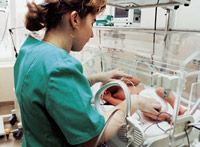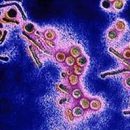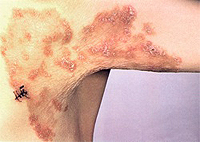What is congenital syphilis? What are the symptoms of congenital syphilis? Answers to these questions you will find in the article.
Content
Congenital syphilis
It is congenital called syphilis, which is transmitted to the future child transplascentary (infection
Fetal caused by the penetration of the causative agent of infection through a placenta) through the blood of the mother. Congenital syphilis happens early and late.
The early congenital syphilis includes the syphilis of the fetus, the syphilis of the breastside and the syphilis of early childhood.
Late congenital syphilis is usually detected after 15-16 years, and before
then does not manifest itself. However, sometimes the symptoms of the late
Congenital syphilis manifest itself, starting from the third year of life.
The syphilis of the fetus occurs around the 5th month of pregnancy, when pale
Treponami penetrate the placenta and actively multiply
inside the body of the fetus.
Syphilis fetal striking literally all internal
organs, brain and bone fetal system, so chances
Survive the fetus is very low. Usually syphilis fetal ends
his death on the 6-7th lunar month of pregnancy or premature
Born the Dead Child.
According to medical literature, 89% of pregnancies in women, patients with secondary
syphilis, ends fetal death or birth
Dead baby.
Part of children, transplacentary contaminated syphilis, survives, but
Often such children, especially those born with active manifestations
syphilis, turn out to be unwillingly and die in the first days or
Months after birth.
If the child stays alive, he usually has very strong
Violations of all organism systems. Children with early congenital syphilis
Weakened, poorly developing, lagging behind in the growth and mass of the body, underdeveloped
both physically and mentally.
In children with early innate chest syphilis, eyes are often amazed, as well as internal organs: liver, spleen, cardiovascular system.
In the early congenital syphilis, skin lesions, bones often observe
and cartilage, teeth. Can develop brain watering or
syphilitic inflammation of brain shells.
Symptoms of congenital syphilisa
Early congenital syphilis in children can flow as with
symptoms of syphilis, then
There are skin rashes and in hidden form - asymptomatic.
However, with hidden congenital
syphilis disease is easy to determine by positive
Serological reactions in the blood and spinal
liquids.
In children with early congenital syphilis aged 1 to 2 years old can manifest themselves:
- Papulse (Characterized by the presence of papules) rash. Around the rear pass, in the field of genital organs, buttocks, less often on
mucous meal, larynx, nose. Papulas can be localized on the palms and
soles on the skin of the face, mainly around the mouth and on the chin,
less often in the forehead and abrasion arc. At the same time around the mouth is formed
Radially sprinkled cracks that, halting, form
peculiar raude scars. These scars are very characteristic
a sign of congenital syphilis remaining for life.
 Syphilitic bubble. The most common type of syphilitic rash in the early
Syphilitic bubble. The most common type of syphilitic rash in the early
Congenital syphilis. Syphilitic bubble is
Bubbles, localized most often on the palms and soles of the child, less often - on the bending surfaces of the forearm and the legs or on the body.
Bubble is often observed at the birth of a child or arises
In the first days and weeks of his life.
- syphilitic rhinitis. Is also a characteristic feature of congenital syphilis in children
Breast-age. Rinith in syphilis arises due to inflammation,
which papulese rash causes the nose mucous membrane. With syphilitic ritin nasal breathing difficult, the child is forced to breathe mouth.
- Osteochondrith. Another sign of early congenital syphilis in children of chest
age - that is, a syphilitic bone defeat. Osteochondrith
striking most often the limb, causing local tensions, swelling and
soreness in the damage zone.
- Periostites and ostepheritats (acute or chronic inflammation of the periosteum). Symptoms of disruption of the bone system with early congenital syphilis are observed in 70-80% of patients.
After the first year of the disease Symptoms of early congenital syphilis,
As a rule, disappear. As with syphilis purchased in adult
age, recurrent rash on the skin and mucous membranes in the form
Roseola or Papul. In addition, damage to the larynx, bones,
nervous system, liver, spleen and other organs.
As for the late congenital syphilis, he also can flow
in a hidden form in the presence of positive serological reactions, and
can manifest themselves with certain clinical symptoms. Usually,
Late congenital syphilis is revealed at the age of 15-16, sometimes
later, but sometimes before.
The most dangerous symptoms of the late congenital syphilis:
- eye damage (sometimes up to full blindness);
- damage to the inner ear (syphilitic labyrinth with an irreversible deafness);
- Gumma (Wevils formed in tissues due to infection) internal organs and skin;
- Changing the shape of the teeth (in which a semi-lunar recess appears on the free edge of the upper cutters).
Probable signs of late congenital syphilis include:
- «Sablevoid» shin;
- scars around the mouth;
- Saddle-shaped nose (in 15-20% of patients there is a characteristic feature,
caused by the destruction of nasal bones and bone nasal
partitions);
- On the skin of the patient can form tubercles and gums;
- Very often arises the defeat of the endocrine system.
Prevention of congenital syphilisa
Congenital syphilis can be cured using modern medicine,
And you need to do it as soon as possible, as long as the conditioned
syphilis changes in the body of the child did not become irreversible.
Therefore, before pregnancy, a woman suffered
syphilis, must certainly consult with a venereologist,
And if the Mother's disease became known during pregnancy,
A woman needs to undergo a course of the treatment of syphilis itself
and conduct preventive treatment of the child immediately
same after birth.









